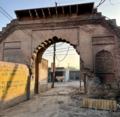Elliott Colvin (died 1883)
From Wikipedia, the free encyclopedia
Elliott Graham Colvin (1836–1883) was a British Indian Civil Service (ICS) Officer. He served in Mathura and Meerut during the Indian Rebellion of 1857 and later became Meerut's Commissioner. After his death, a gate was erected in his memory in Bulandshahr on the instructions of Frederic Growse.
Elliott Graham Colvin | |
|---|---|
 Colvin Gate memorial, Bulandshahr | |
| Personal details | |
| Born | 1836 Calcutta, British India |
| Died | 3 November 1883 Sahanpur, Uttar Pradesh, India |
Early life and family
Elliott Colvin was born in 1836 in Calcutta, now Kolkata, to John Russell Colvin.[1][2][a] His siblings included Auckland Colvin and Walter Colvin.[4][5] In 1850 he became a naval cadet.[6] He was educated at Eton and from 1853 to 1855 was at Haileybury.[7][4][8]
On 18 September 1862 in Nainital, he married Edith, the eldest daughter of Peter Cunningham.[9][10][b] The Times of India later noted that "he was peculiarly happy in his married life".[4] He learnt French, German and Russian, and was familiar with several Northern Indian dialects.[4]
Career
Colvin returned to India on 6 November 1855.[13] In November 1856 he was attached to the North-West Provinces where he was posted assistant in the Agra division and then assistant magistrate and collector to Agra.[13] In May 1857, at the onset of the Indian Rebellion of 1857, he was transferred to Mathura.[4][13] He fought at Hathras, Aligarh and the surrounding areas.[14][15] He also became well known at Budaun.[4] He spent a few months at Meerut before being appointed as superintendent of the Terai District towards Rohilkhand.[4][16] Between 1857 and 1878, he also held various posts at Meerat, Bareilly, Moradabad, Benares.[13]
In 1880 Colvin held posts in Muzaffarnagar and Benares.[2][13] Later, he became settlement officer, collector and commissioner back at Meerut.[4] There, he led the search for European graves and commissioned maintenance of the burial sites.[14]
Death and legacy
At the age of 47, Colvin's health began to deteriorate.[4] He died of "inflammation of the lungs" on 3 November 1883 at Sahanpur, and his body was taken to Meerut.[4][17][18] He was buried at Meerut cemetery.[4] At Meerut, he was succeeded by Mr. Quinton, a member of the Viceregal Council.[19]
Following his death, a gate in his memory was constructed at a cost of 4,000 rupees at the east wall of Moti Bagh in Bulandshahr, Uttar Pradesh, at the instruction of Frederic Growse.[20] Growse wrote in his 1884 book Bulandshahr; or, Sketches of an Indian district; social, historical and architectural that Colvin's "sudden untimely death, on the 3rd November 1883, was deeply felt by all classes of the community".[20] An illustration of the gate was planned for inclusion in the second part of Growse's Indian Architecture of To-day as Exemplified in New Buildings in the Bulandshahr District.[21]
Colvin gate
- Facing market
- Facing Moti Bagh
- Memorial plaque facing Moti Bagh
- Inside arch
Notes
References
Wikiwand - on
Seamless Wikipedia browsing. On steroids.




